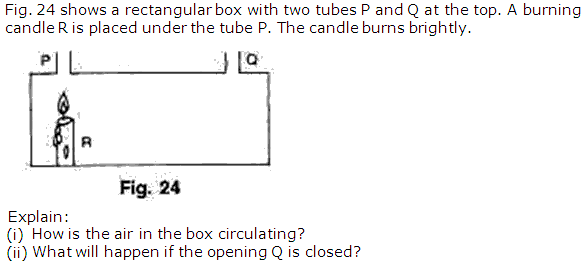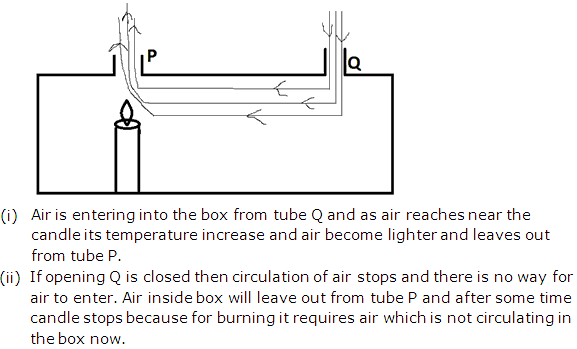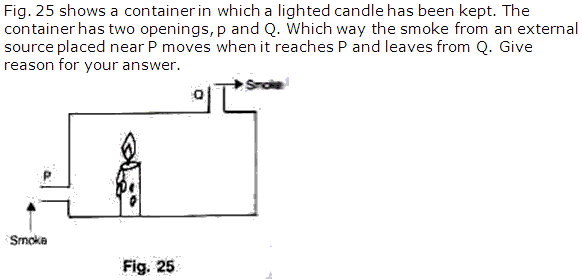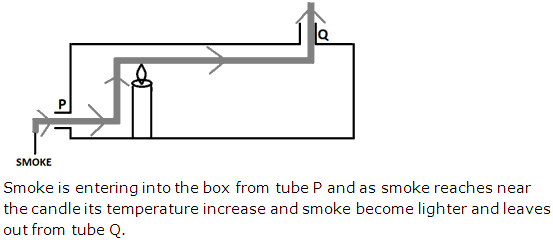Chapter 5 - Heat - Transmission of Heat Exercise 226
Question 1
State three models of transfer of heat.
Solution 1
Conduction, convection and radiation are three modes of transfer of heat.
Question 2
Is air a good conductor of heat?
Solution 2
No, air is not a good conductor of heat.
Question 3
Among solids ebonite and asbestos are the worst conductors of heat. Is it a correct statement?
Solution 3
Yes, this is a correct statement. Ebonite and asbestos are worst conductor of heat.
Question 4
Why are cooking utensils made of metals?
Solution 4
Cooking utensils are made up of metals because metals are good conductors of heat and they easily allow the heat to pass through them.
Question 5
Why are hollow bricks used in the construction of cold storage rooms?
Solution 5
Brick is bad conductor of heat, hence bricks greatly reduce the conduction of heat from outside to the room. In order to ensure better insulation, bricks are made hollow so that air filled between these gaps provides insulation to heat.
Question 6
Name a liquid which is a good conductor of heat.
Solution 6
Mercury is good conductor of heat.
Question 7
In cold countries, why do windows have two glass panes with a thin layer of air in between them?
Solution 7
In cold countries, windows have two glass panes and a thin layer of air in between these two glass panes because air is a poor conductor of heat; it obstructs the conduction of heat from the room to the outside.
Question 8
Arrange the following in order of increasing heat conductivity: copper, air water, mercury.
Solution 8
Order of increasing heat conductivity:
Air < water< mercury < copper.
Air < water< mercury < copper.
Question 9
Explain the following:
(i) Water is heated generally from below.
(ii) In a solid, heat is not transferred by the process of convection.
(iii) Conduction is not possible in vacuum.
(iv) Why is the cooling in a refrigerator kept near the top?
(v) It is cool in the shade, when it is hot outside.
(i) Water is heated generally from below.
(ii) In a solid, heat is not transferred by the process of convection.
(iii) Conduction is not possible in vacuum.
(iv) Why is the cooling in a refrigerator kept near the top?
(v) It is cool in the shade, when it is hot outside.
Solution 9
(i) Water is heated from below because water is heated by process of convection and in process of convection heat always flows in upward direction from downward direction.
(ii) In process of convection heat is transferred from one point to another by actual movement of particles of medium and as particles of solid cannot move so process of convection is not possible in case of solids.
(iii) Conduction is not possible in Vacuum because process of conduction require a material medium for transfer of heat.
(iv) Inside the refrigerator, cooling takes place by convection. The freezing chamber at the top produces cool and heavy air which descends and hot air from below goes up setting convection current. Thus, cooling in a refrigerator is kept near the top.
(v) As earth surface gets heated by sun rays and due to process of convection the air near earth surface open to sunlight get heated while in shade sun rays does not fall on earth surface so air near that surface would not heat up.
(ii) In process of convection heat is transferred from one point to another by actual movement of particles of medium and as particles of solid cannot move so process of convection is not possible in case of solids.
(iii) Conduction is not possible in Vacuum because process of conduction require a material medium for transfer of heat.
(iv) Inside the refrigerator, cooling takes place by convection. The freezing chamber at the top produces cool and heavy air which descends and hot air from below goes up setting convection current. Thus, cooling in a refrigerator is kept near the top.
(v) As earth surface gets heated by sun rays and due to process of convection the air near earth surface open to sunlight get heated while in shade sun rays does not fall on earth surface so air near that surface would not heat up.
Question 10

Solution 10

Question 11

Solution 11

Question 12
Define the process of conduction.
Solution 12
The process of conduction involves the transmission of heat from the hot end to the cold end from particle to particle of the medium.
Question 13
Is conduction possible in vacuum?
Solution 13
No, conduction is not possible in vacuum.
Question 14
What is meant by thermal insulation?
Solution 14
Thermal insulation means restriction of transfer of heat by any means.
Question 15
What is the main difference between good and bad conductors of heat?
Solution 15
Good conductor allow heat to pass through them easily while bad conductor of heat does not allow heat to pass them.
Question 16
Are liquids good conductors of heat?
Solution 16
No, liquids are poor conductors of heat.
Question 17
Out of metals, liquids and gases:
(i) Which one is best conductor of heat?
(ii) Which one is worst conductor of heat?
(i) Which one is best conductor of heat?
(ii) Which one is worst conductor of heat?
Solution 17
(i) Metals are the best conductor of heat.
(ii) Gases are the worst conductor of heat.
(ii) Gases are the worst conductor of heat.
Question 18
Name the metal which is most conducting.
Solution 18
Among all the metals, Silver is most conducting.
Question 19
Name the substance which is most non-conducting.
Solution 19
Air is most non-conducting.
Chapter 5 - Heat - Transmission of Heat Exercise 227
Question 1
Name the process by which we receive heat from the sun.
Solution 1
We receive heat from sun by process of Radiation.
Question 2
How can the radiating power of a surface be increased?
Solution 2
Radiating power of a surface can be increased by blackening it.
Question 3
At what speed does the heat radiation travel? What path does it follow?
Solution 3
Heat radiation travels with speed of light and always follows straight path.
Question 4
Draw a labeled diagram of a vacuum flask and explain how the heat transfer minimized in it.
Solution 4
The flask consists of a double walled glass container with vacuum between the walls A and B. The inner side of A and the outer side of B are silvered. It has a narrow mouth which is closed by a non-conducting rubber stopper.
If a hot liquid is placed inside the flask, it cannot lose heat by conduction or convection, as there is no air between the walls. The small amount of heat lost from the liquid by radiation is reflected back into the liquid by silvering of the inner wall A and any radiation striking the outer wall B, is reflected back and prevented from reaching the liquid.
If a hot liquid is placed inside the flask, it cannot lose heat by conduction or convection, as there is no air between the walls. The small amount of heat lost from the liquid by radiation is reflected back into the liquid by silvering of the inner wall A and any radiation striking the outer wall B, is reflected back and prevented from reaching the liquid.
Question 5
What is a greenhouse? How does the air inside it remain warm?
Solution 5
Green house is a glass house constructed to keep delicate and rare plants that require warmth and protection from weather. It is constructed by panels of glass. The temperature in a green house rises because heat enters the house through the glass but cannot escape out, because the glass reflects the heat back to the inside of the house. This makes glass house warmer than the outside environment.
Question 6
Describe an experiment to show that a blackened surface is a better emitter of heat than a polished surface.
Solution 6
Take two sheets of tin plates, one blackened and the other is polished brightly. Fix some drawing pins on the outer side of both sheets using wax. Fix these plates vertically at a very short distance apart. Place a Bunsen burner midway between them. When you light the burner you will observe that the pins from the black painted sheet start dropping while the pins on the polished surface remain in the same position for much longer time.
Thus, we can conclude that black surface is better absorber of heat than the polished one.
Thus, we can conclude that black surface is better absorber of heat than the polished one.
Question 7
How will you minimize heat loss due to each of the following:
(a) Convection
(b) Conduction and
(c) Radiation?
(a) Convection
(b) Conduction and
(c) Radiation?
Solution 7
(i) As convection require medium for transfer of heat so heat loss due to convection can be minimized if the substance is kept away from any material medium.
(ii) Similarly for conduction, as conduction also require medium for transfer of heat so heat loss due to conduction can be minimized if the substance is kept away from any material medium.
(iii) Heat loss due to radiation can be minimized by polishing the surface as polished surfaces radiate less heat.
(ii) Similarly for conduction, as conduction also require medium for transfer of heat so heat loss due to conduction can be minimized if the substance is kept away from any material medium.
(iii) Heat loss due to radiation can be minimized by polishing the surface as polished surfaces radiate less heat.
Question 8
A red hot ball is suspended from the ceiling of a room using a thin metallic wire.
(i) Name the ways in which the ball loses heat.
(ii) Suggest the way by which it loses the least amount of heat.
(iii) Explain what role does the air in the room play in the loss of heat.
(i) Name the ways in which the ball loses heat.
(ii) Suggest the way by which it loses the least amount of heat.
(iii) Explain what role does the air in the room play in the loss of heat.
Solution 8
(i) As no material medium surrounds the ball so there is no possibility of losing heat by conduction or convection. The ball will lose heat by Radiation.
(ii) Ball will lose minimum amount of heat if it is polished.
(iii) As loss of heat take place by Radiation and process of radiation does not require any material medium, so there is no role of air in loss of heat.
(ii) Ball will lose minimum amount of heat if it is polished.
(iii) As loss of heat take place by Radiation and process of radiation does not require any material medium, so there is no role of air in loss of heat.
Question 9
Explain the terms CFCs, UV and WHO.
Solution 9
(i) CFC means Chlorofluorocarbons which are produced mainly by refrigeration industries, aerosol cans, coolants, propellants and plastic foams. They cause global warming.
(ii) UV means ultraviolet range of radiations. These are the radiations which are emitted by sun and they enter our atmosphere.
(iii) WHO is World Health Organization which put a check on diseases and global warming etc.
(ii) UV means ultraviolet range of radiations. These are the radiations which are emitted by sun and they enter our atmosphere.
(iii) WHO is World Health Organization which put a check on diseases and global warming etc.
Question 10
What are greenhouse gases?
Solution 10
Green house is a glass house constructed to keep delicate and rare plants that require warmth and protection from weather. It is constructed by panels of glass. The temperature in a green house rises because heat enters the house through the glass but cannot escape out, because the glass reflects the heat back to the inside of the house. This makes glass house warmer than the outside environment. This phenomenon is called green house effect.
Question 11
Name any three greenhouse gases.
Solution 11
Carbon dioxide, Carbon monoxide, methane are green house gases.
Question 12
Why extensive use of fossil fuels should not be made?
Solution 12
As fossil fuels are non-renewable sources of energy they are not available again and again if are fully exhausted, so they should not be used extensively.
Question 13
Define global warming.
Solution 13
Global warming occurs due to the presence of carbon di- oxide, CFCs, methane in the atmosphere. Carbon dioxide acts as a transparent gas to incoming shortwave radiations which the earth re-radiates into space. It therefore traps the outgoing longwave radiations thus warming lower atmosphere of the earth thereby causing global warming.
Question 14
What are the expected effects of global warming?
Solution 14
Harmful effects of global warming are:
(a). The atmospheric temperature of earth would increase thereby making it difficult for a living being to survive.
(b). It would melt down the polar caps thus increasing the size of the ocean and leading to floods, tsunami, etc.
(c). The increase in temperature would affect climate and rainfall thus affecting flora and fauna.
(d). Human beings would be vulnerable to diseases as microbes would get warmth to grow.
(a). The atmospheric temperature of earth would increase thereby making it difficult for a living being to survive.
(b). It would melt down the polar caps thus increasing the size of the ocean and leading to floods, tsunami, etc.
(c). The increase in temperature would affect climate and rainfall thus affecting flora and fauna.
(d). Human beings would be vulnerable to diseases as microbes would get warmth to grow.

0 comments:
Post a Comment